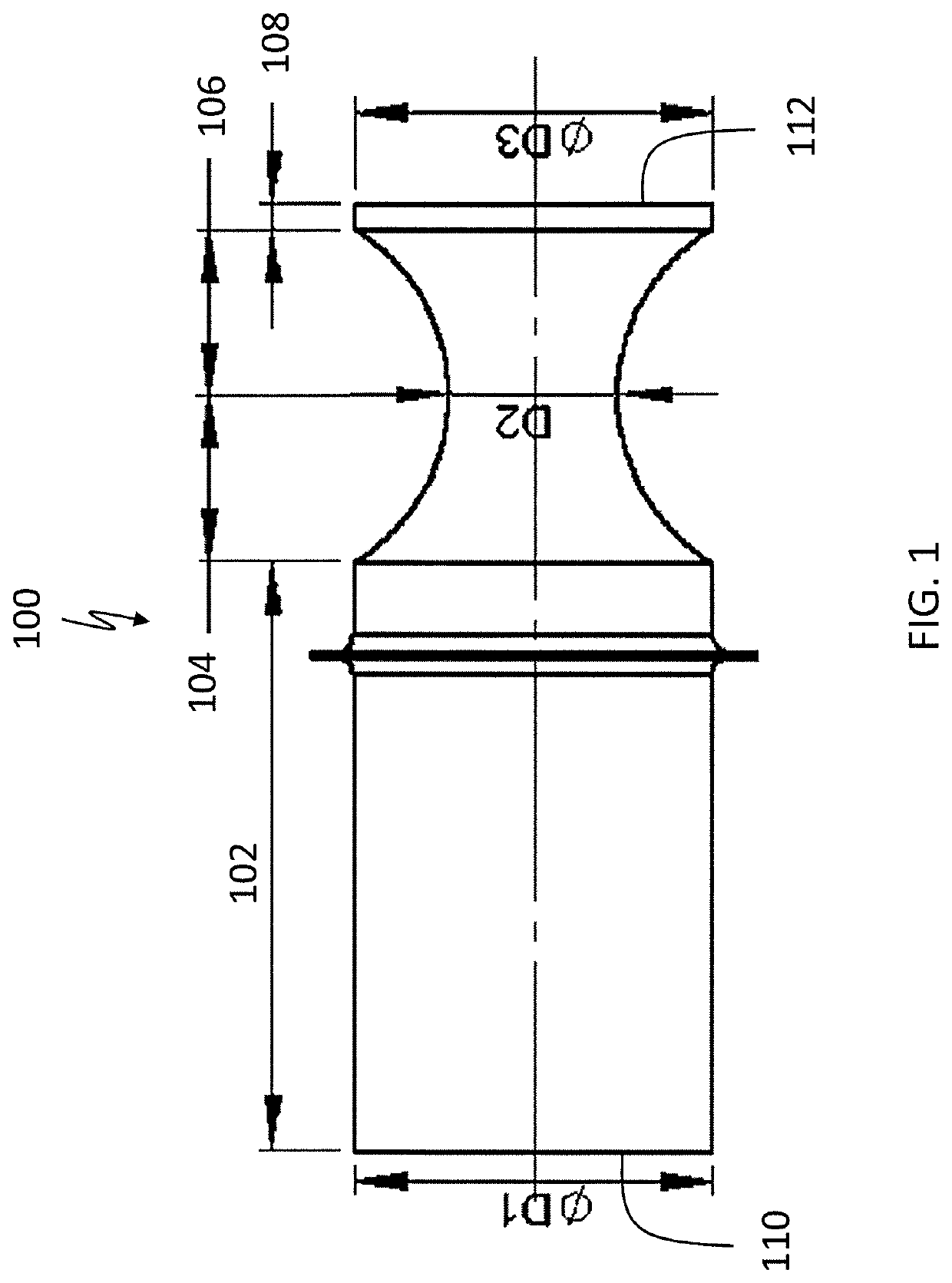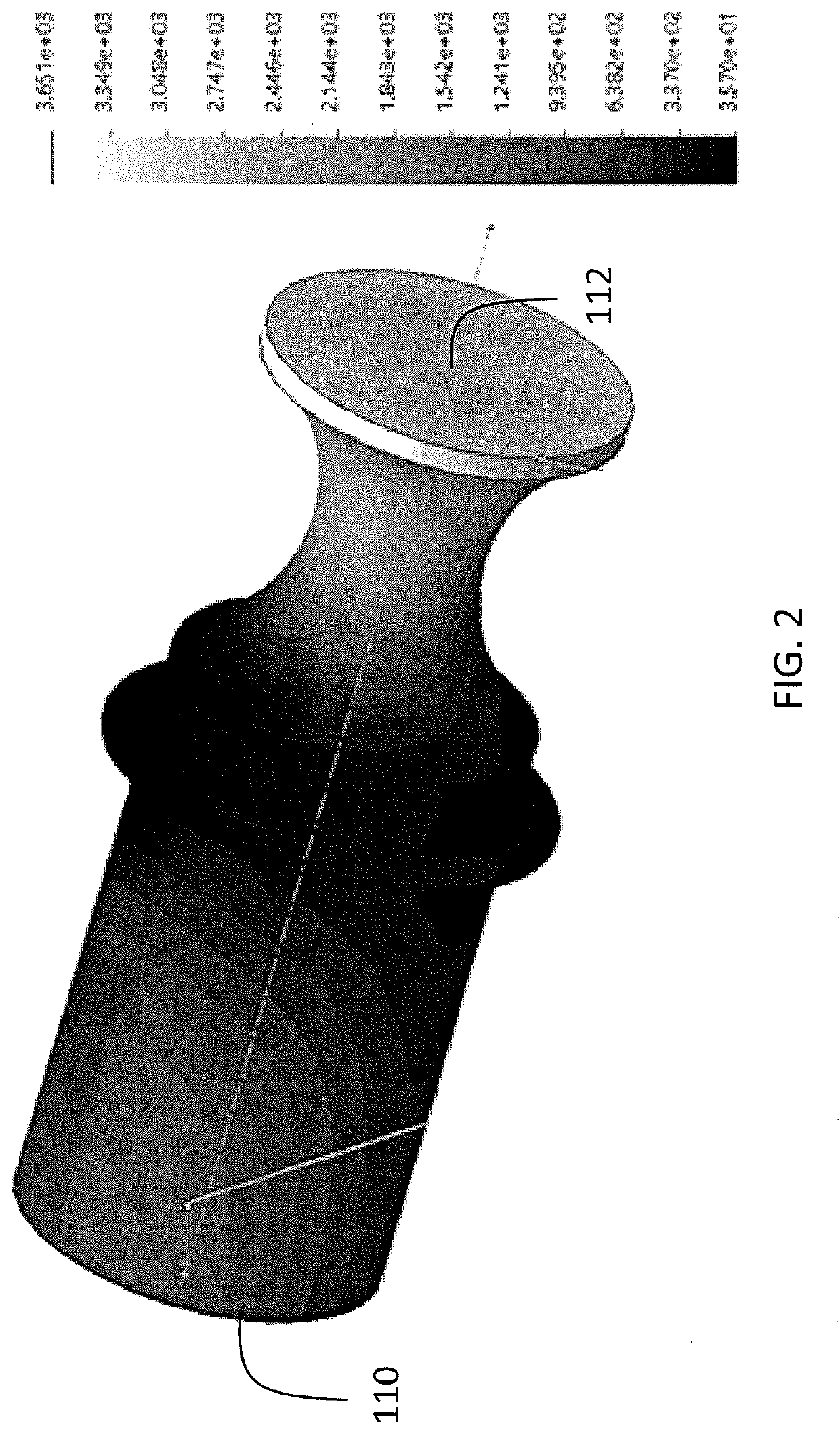Ultrasonic Horn With A Large High-Amplitude Output Surface
a high-amplitude output and ultrasonic technology, applied in the field of ultrasonic generators, can solve the problems of increasing vibration amplitudes, increasing the size of the output tip diameter, and the size of the output surface area, so as to maximize the transfer efficiency of ultrasonic generators, increase the available output radiation surface and the uniform distribution of acoustic energy, and increase the effect of acoustic energy radiation
- Summary
- Abstract
- Description
- Claims
- Application Information
AI Technical Summary
Benefits of technology
Problems solved by technology
Method used
Image
Examples
first embodiment
[0026]Referring to the figures, wherein like numeral refer to like parts throughout, there is seen in FIG. 1 an ultrasonic horn 100 which comprises an entrance cylindrical section 102 having a first diameter D1, connected to a first variable-diameter section 104 with a diminishing diameter to a second diameter D2 (hereinafter referred to as “reducing-diameter section”), connected to a second variable-diameter section 106 with an increasing diameter (hereinafter referred to as “increasing-diameter section”) to diameter D3, connected to an exit cylindrical section 108. FIG. 2 shows the ultrasonic amplitudes for horn 100 in arbitrary units and demonstrates a high gain at the output surface 112 of horn 100. In this embodiment, entrance cylindrical section 102 provides the input surface 110 for ultrasonic energy from a transducer, and cylindrical section 108 provides the main output surface 112 from which the energy is transmitted to a fluid in which the output surface is submerged.
second embodiment
[0027]There is seen in FIG. 3 an ultrasonic horn 200 which comprises an entrance cylindrical section 202 having diameter D1, connected to a reducing-diameter section 204 to a second diameter D2, connected to an increasing-diameter section 206 to diameter D3. FIG. 4 shows the ultrasonic amplitudes for horn 200 in arbitrary units and demonstrates a high gain at the output surface of horn 200. In this embodiment, entrance cylindrical section 202 provides the input surface 210 for ultrasonic energy from a transducer, and increasing-diameter section 206 provides the main output surface 212 from which the energy is transmitted to a fluid in which the output surface is submerged.
third embodiment
[0028]There is seen in FIG. 5 an ultrasonic horn 300 which comprises an entrance cylindrical section 302 of diameter D1, connected to a reducing-diameter section 304 to diameter D2, connected to a thinner intermediate cylindrical section 310 of diameter D2, connected to an increasing-diameter section 306 to diameter D3. FIG. 6 shows the ultrasonic amplitudes for horn 300 in arbitrary units and demonstrates a high gain at the output surface of horn 300. In this embodiment, entrance cylindrical section 302 provides the input surface 310 for ultrasonic energy from a transducer, and increasing-diameter section 306 provides the main output surface 312 from which the energy is transmitted to a fluid in which the output surface is submerged.
[0029]Ultrasonic horn 100, horn 200, or horn 300 of the present invention may be manufactured from the same materials as existing ultrasonic horns, such as titanium alloys and other metals.
[0030]There is seen in FIG. 7, a batch system 400 having an ultr...
PUM
 Login to View More
Login to View More Abstract
Description
Claims
Application Information
 Login to View More
Login to View More - R&D
- Intellectual Property
- Life Sciences
- Materials
- Tech Scout
- Unparalleled Data Quality
- Higher Quality Content
- 60% Fewer Hallucinations
Browse by: Latest US Patents, China's latest patents, Technical Efficacy Thesaurus, Application Domain, Technology Topic, Popular Technical Reports.
© 2025 PatSnap. All rights reserved.Legal|Privacy policy|Modern Slavery Act Transparency Statement|Sitemap|About US| Contact US: help@patsnap.com



